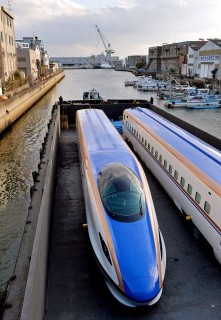Loading
Search
▼ Why Hyogo is Japan’s Switzerland
- Category:Tourism

MYDIGITALFC
Japan is divided into 47 administrative units called prefectures. Each of these prefectures is headed by a governor who is elected by the people. Unlike India, Japan does not have a federal system, so the powers of the prefectures cannot be compared with that of Indian states. However, the prefectures that vary greatly in terms of size of territory, population and economic strength, present a Japan that is much more diverse than is usually perceived by the outside world. There are strong variations in regional dialects, in climate and culture as well as in people’s way of life. Recently we had an extensive visit to Hyogo prefecture which neighbours Osaka. Its capital Kobe was amongst the first harbour cities to be opened to the outside world in the second half of the 19th century. Since then it has had a strong cosmopolitan character. Within Japan, Kobe hosts the strongest and most influential Indian community, with many Indian business families living here for several generations.
Hyogo prefecture is the only prefecture on the main island of Honshu that has a coastline both to the Pacific Ocean and to the Sea of Japan. With some 8,400 square kilometres, it ranks 12th and its 5.6 million inhabitants make it the seventh largest prefecture.
Japan has two major population and economic agglomerations: first, Kanto with Tokyo and Yokohama at its core, and secondly, Kansai with Osaka as its centre. Kobe belongs to the Kansai region and is closely integrated into its sophisticated infrastructure. Kansai’s GDP is equivalent to the GDP of Netherlands. Traditionally Osaka has been Japan’s commercial capital. In olden, feudal times of the Shogun, it was the centre of commerce in rice, Japan’s most valuable commodity, which served as an assessment of feudal wealth. However, in recent decades, Tokyo has gained in importance and today it is not only the political but also the economic capital of Japan.
Most impressive is the economic structure of Hyogo. It is known for its agricultural wealth, producing some of Japan’s best sakes. Kobe beef has become a household name amongst gourmets in the world who deem it to be the best beef Japan produces. As a large part of the prefecture is covered in forest and agriculture dominates in the valleys, Hyogo can rightly claim to be the Switzerland of Japan. The only thing missing are snow-capped mountains. In any case, Nestlé, the Swiss food multinational, which is operating in Japan for over 100 years, has kept its headquarters in Hyogo, resisting the drift to Kanto.
In essence, Hyogo is the land of the small and medium enterprises (SMEs). Thousands of them are listed there. Like in southern Germany and Switzerland there are many SMEs that are traditional family firms and in some cases have a major share even in world markets. These highly specialised enterprises want to keep their independence and many of them face tough competition from Chinese companies that often copy technologies. How to deal with the copy threat is a matter of survival for many of them. What companies have done to face this threat is as varied as the economic circumstances in China. Some SMEs have resisted from going to China. Others have increased their service capabilities. The after sale service they can offer is of such a quality that many a customer will think twice before buying the cheaper product. Finally, there are SMEs that have taken up the challenge and have successfully gone to court in China.
The great phase of industrialisation had brought heavy industry to Hyogo. The Kobe Steel company is of emblematic importance. Today Kawasaki Heavy Industries is the major industrial operator in Hyogo. Amongst its many sophisticated products is the Shinkansen super express, another symbol of modern Japan! In a wise move, the prefectural government in Kobe has been trying to attract modern industries that rely more on brain power and technology than iron and steel. As a result, Kobe and Hyogo prefecture are home to many interesting companies that attract the most sophisticated talents in the country. In Kobe, we find the K Computer, amongst the world’s four largest super computers. Unlike its rivals in the US and China, the Japanese have opened the usage of the K computer to private companies that can use it for very difficult and otherwise time-consuming investigations.
Finally, of particular interest is the medical cluster that has been established on an artificial island in the bay of Kobe. Here, in a very congenial atmosphere, new ideas and concepts of medical treatments are to be developed. Soon, in January 2015, it will be 20 years since the devastating Great Hanshin earthquake. Today no traces of that huge disaster are left. It is remarkable how Kobe has recovered and through mere will power has once again taken the reigns of social and industrial development into its own hands.
- October 28, 2014
- Comment (0)
- Trackback(0)

